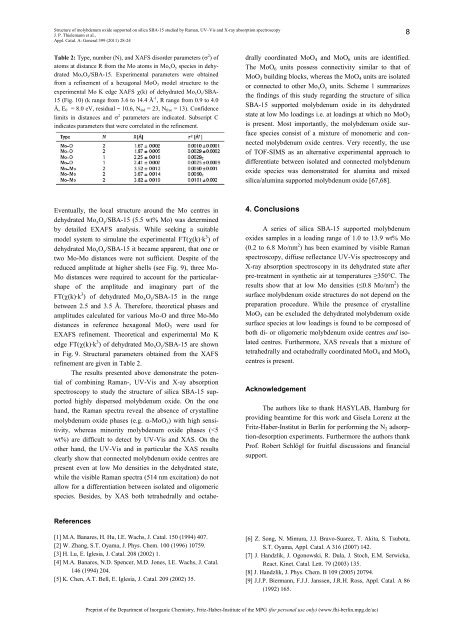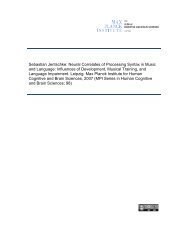<str<strong>on</strong>g>Structure</str<strong>on</strong>g> <str<strong>on</strong>g>of</str<strong>on</strong>g> <str<strong>on</strong>g>molybdenum</str<strong>on</strong>g> <str<strong>on</strong>g>oxide</str<strong>on</strong>g> <str<strong>on</strong>g>supported</str<strong>on</strong>g> <strong>on</strong> <strong>silica</strong> <strong>SBA</strong>-<strong>15</strong> <strong>studied</strong> by Raman, UV–Vis and X-ray absorpti<strong>on</strong> spectroscopy J. P. Thielemann et al., Appl. Catal. A: General 399 (2011) 28-24 Table 2: Type, number (N), and XAFS disorder parameters (� 2 ) <str<strong>on</strong>g>of</str<strong>on</strong>g> atoms at distance R from the Mo atoms in MoxOy species in dehydrated MoxOy/<strong>SBA</strong>-<strong>15</strong>. Experimental parameters were obtained from a refinement <str<strong>on</strong>g>of</str<strong>on</strong>g> a hexag<strong>on</strong>al MoO3 model structure to the experimental Mo K edge XAFS �(k) <str<strong>on</strong>g>of</str<strong>on</strong>g> dehydrated MoxOy/<strong>SBA</strong>- <strong>15</strong> (Fig. 10) (k range from 3.6 to 14.4 Å -1 , R range from 0.9 to 4.0 Å, E0 = 8.0 eV, residual ~ 10.6, Nind = 23, Nfree = 13). C<strong>on</strong>fidence limits in distances and � 2 parameters are indicated. Subscript C indicates parameters that were correlated in the refinement. Eventually, the local structure around the Mo centres in dehydrated Mo xO y/<strong>SBA</strong>-<strong>15</strong> (5.5 wt% Mo) was determined by detailed EXAFS analysis. While seeking a suitable model system to simulate the experimental FT(�(k)∙k 3 ) <str<strong>on</strong>g>of</str<strong>on</strong>g> dehydrated Mo xO y/<strong>SBA</strong>-<strong>15</strong> it became apparent, that <strong>on</strong>e or two Mo-Mo distances were not sufficient. Despite <str<strong>on</strong>g>of</str<strong>on</strong>g> the reduced amplitude at higher shells (see Fig. 9), three Mo- Mo distances were required to account for the particularshape <str<strong>on</strong>g>of</str<strong>on</strong>g> the amplitude and imaginary part <str<strong>on</strong>g>of</str<strong>on</strong>g> the FT(�(k)∙k 3 ) <str<strong>on</strong>g>of</str<strong>on</strong>g> dehydrated Mo xO y/<strong>SBA</strong>-<strong>15</strong> in the range between 2.5 and 3.5 Å. Therefore, theoretical phases and amplitudes calculated for various Mo-O and three Mo-Mo distances in reference hexag<strong>on</strong>al MoO 3 were used for EXAFS refinement. Theoretical and experimental Mo K edge FT(�(k)∙k 3 ) <str<strong>on</strong>g>of</str<strong>on</strong>g> dehydrated Mo xO y/<strong>SBA</strong>-<strong>15</strong> are shown in Fig. 9. Structural parameters obtained from the XAFS refinement are given in Table 2. The results presented above dem<strong>on</strong>strate the potential <str<strong>on</strong>g>of</str<strong>on</strong>g> combining Raman-, UV-Vis and X-ay absorpti<strong>on</strong> spectroscopy to study the structure <str<strong>on</strong>g>of</str<strong>on</strong>g> <strong>silica</strong> <strong>SBA</strong>-<strong>15</strong> <str<strong>on</strong>g>supported</str<strong>on</strong>g> highly dispersed <str<strong>on</strong>g>molybdenum</str<strong>on</strong>g> <str<strong>on</strong>g>oxide</str<strong>on</strong>g>. On the <strong>on</strong>e hand, the Raman spectra reveal the absence <str<strong>on</strong>g>of</str<strong>on</strong>g> crystalline <str<strong>on</strong>g>molybdenum</str<strong>on</strong>g> <str<strong>on</strong>g>oxide</str<strong>on</strong>g> phases (e.g. �-MoO 3) with high sensitivity, whereas minority <str<strong>on</strong>g>molybdenum</str<strong>on</strong>g> <str<strong>on</strong>g>oxide</str<strong>on</strong>g> phases (
<str<strong>on</strong>g>Structure</str<strong>on</strong>g> <str<strong>on</strong>g>of</str<strong>on</strong>g> <str<strong>on</strong>g>molybdenum</str<strong>on</strong>g> <str<strong>on</strong>g>oxide</str<strong>on</strong>g> <str<strong>on</strong>g>supported</str<strong>on</strong>g> <strong>on</strong> <strong>silica</strong> <strong>SBA</strong>-<strong>15</strong> <strong>studied</strong> by Raman, UV–Vis and X-ray absorpti<strong>on</strong> spectroscopy J. P. Thielemann et al., Appl. Catal. A: General 399 (2011) 28-24 [10] I. Nova, L. Lietti, L. Casagrande, L. Dall’Acqua, E. Giamello, P. Forzatti, Appl. Catal. B 17 (1998) 245. [11] A.N. Desikan, W. Zhang, S.T. Oyama, J. Catal. <strong>15</strong>7 (1995) 740. [12] G. Tsilomelekis, A. Christodoulakis, S. Boghosian, Catal. Today 127 (2007) 139. [13] T. Ono, H. Kamisuki, H. Hisashi, H. Miyata, J. Catal. 116 (1989) 303. [14] M.A. Banares, H. Hu, I.E. Wachs, J. Catal. <strong>15</strong>5 (1995) 249. [<strong>15</strong>] T. Ressler, A. Walter, Z.-D. Huang, W. Bensch, J. Catal. 254 (2008) 170. [16] Z. Huang, W. Bensch, W. Sigle, P.A. van Aken, L. Kienle, T. Vitoya, H. Modrow, T. Ressler, J. Mater. Sci. 43 (2008) 244. [17] Y. Lou, H. Wang, Q. Zhang, Y. Wang, J. Catal. 247 (2007) 245. [18] P.C. Bakala, E. Briot, L. Salles, J.M. Brégeault, Appl. Catal. A 300 (2006) 91. [19] J.A. Melero, J. Iglesias, J.M. Arsuaga, J. Sainz-Pardo, P. de Frutos, S. Blazquez, Appl. Catal. A 331 (2007) 84. [20] H. Balcar, D. Mishra, E. Marceau, X. Carrier, N. Zilkova, Z. Bastl, Appl. Catal. A 359 (2009) 129. [21] J.P. Thielemann, J. Kröhnert, C. Hess, J. Phys. Chem. C 114 (2010) 17092. [22] H. Hu, I.E. Wachs, S.R. Bare, J. Phys. Chem. 99 (1995) 10897. [23] C.C. Williams, J.G. Ekerdt, J.M. Jehng, F.D. Hardcastle, A.M. Turek, I.E. Wachs, J. Phys. Chem. 95 (1991) 8781. [24] S. Chempath, Y. Zhang, A.T. Bell, J. Phys. Chem. C 111 (2007) 1291. [25] N. Ohler, A.T. Bell, J. Phys. Chem. B 110 (2006) 2700. [26] N. Ohler, A.T. Bell, J. Phys. Chem. B 109 (2005) 23419. [27] E.L. Lee, I.E. Wachs, J. Phys. Chem. C 112 (2008) 6487. [28] Y. Iwasawa, K. Asakura, H. Ishii, H. Kuroda, Z. Phys. Chem. 144 (1985) 105. [29] Y. Iwasawa, Adv. Catal. 35 (1987) 265. [30] Y.V. Plyuto, I.V. Babich, I.V. Plyuto, A.D. Van Langeveld, J.A. Moulijn Coll. Surf. A 125 (1997) 225. [31] E.L. Lee, I.E. Wachs, J. Phys. Chem. C 111 (2007) 14410. [32] C. Hess, ChemPhysChem 10 (2009) 319. [33] A. Walter, R. Herbert, C. Hess, T. Ressler, Chem. Central J. 4 (2010) 3. [34] C. Hess, U. Wild, R. Schlögl, Microp. Mesop. Mat. 95 (2006) 339. [35] M. Cavalleri, K. Hermann, A. Knop-Gericke, M. Hävecker, R. Herbert, C. Hess, A. Oestereich, J. Döbler, R. Schlögl, J. Catal. 262 (2009) 2<strong>15</strong>. [36] T.V. Venkov, C. Hess, F.C. Jent<str<strong>on</strong>g>of</str<strong>on</strong>g>t, Langmuir 23 (2007) 1768. [37] D.Y. Zhao, J.L. Feng, Q.S. Huo, N. Melosh, G.H. Fredricks<strong>on</strong>, B.F. Chmelka, G.D. Stucky, Science 279 (1998) 548. [38] D. Zhao, Q. Huo, J. Feng, B.F. Chmelka, G.D. Stucky, J. Am. Chem. Soc. 120 (1998) 6024. [39] C. Hess, J.D. Hoefelmeyer, T.D. Tilley, J. Phys. Chem. B 108 (2004) 9703. [40] S. Brunauer, P.H. Emmett, E. Teller, J. Am. Chem. Soc. 60 (1938) 309. [41] L. Jelinek, E. Kováts, Langmuir 10 (1994) 4225. [42] T. Ressler, J. Synch. Rad. 5 (1998) 118. [43] J.J. Rehr, C.H. Booth, F. Bridges, S.I. Zabinsky, Phys. Rev. B 49 (1994) 12347. [44] T. Ressler, S.L. Brock, J. W<strong>on</strong>g, S.L. Suib, J. Phys. Chem. B 103 (1999) 6407. [45]http://www.ixasportal.net/ixas/images/ixas_mat/StandardsCrite ria_July25_2000.pdf (accessed 2/1/2010). [46] Numerical Recipes: The Art <str<strong>on</strong>g>of</str<strong>on</strong>g> Scientific Computing, Third Editi<strong>on</strong> (2007), Cambridge University Press (www.nr.com). [47] R. Herbert, D. Wang, R. Schomäcker, R. Schlögl, C. Hess, ChemPhysChem 10 (2009) 2230. [48] T.M. McEvoy, K.J. Stevens<strong>on</strong>, Langmuir 21 (2005) 3521. [49] The small signal at 422 cm -1 originates from the sample holder. [50] C.J. Brinker, R. Kirkpatrick, D.R. Tallant, B.C. Bunker, B. M<strong>on</strong>tez, J. N<strong>on</strong>-Cryst. Solids 99 (1988) 418. [51] D.R. Tallant, B.C. Bunker, C.J. Brinker, C.A. Balfe, Mater. Res. Soc. Symp. Proc. 73 (1986) 261. [52] B.C. Brinker, D.R. Tallant, E.P. Roth, C.S. Ashley, Mater. Res. Soc. Symp. Proc. 61 (1986) 387. [53] R.H. Stolen, G.E. Walrafen, J. Chem. Phys. 64 (1986) 2623. [54] M. de Boer, A.J. van Dillen, D.C. K<strong>on</strong>ingsberger, J.W. Geus, M.A. Vuurman, I.E. Wachs, Catal. Lett. 11 (1991) 227. [55] C.C. Williams, J.G. Ekerdt, J.M. Jehng, F.D. Hardcastle, A.M. Turek, I.E. Wachs, J. Phys. Chem. 95 (1991) 8781. [56] I.G. Shenderovich, G. Buntkowsky, A. Schreiber, E. Gedat, S. Sharif, J. Albrecht, N.S. Golubev, G.H. Findenegg, H.H. Limbach, J. Phys. Chem. B 107 (2003) 11924. [57] L.J. Gregoriades, J. Döbler, J. Sauer, J. Phys. Chem. C 114 (2010) 2967. [58] The change in intensity ratio was observed during treatment <str<strong>on</strong>g>of</str<strong>on</strong>g> MoxOy/<strong>SBA</strong>-<strong>15</strong> (2.0 Mo/nm 2 ) in synthetic air (O2/N2/H2O =10/90/0) at 500°C and switching to an atmosphere c<strong>on</strong>taining a high amount <str<strong>on</strong>g>of</str<strong>on</strong>g> steam (O2/N2/H2O =10/45/45). [59] R.K. Rana, B. Viswanathan, Catal. Lett. 52 (1998) 25. [60] S. Higashimoto, Y .Hua, R. Tsumura, K. Iino, M. Matsuoka, H. Yamashita , Y.G. Shul, M. Che, M. Anpo J. Catal. 235 (2005) 272. [61] J.Y. Piquemal, J.-M. Manoli, P. Beaunier, A. Ensuque, P. Tougne, A.P. Legrand, J.M. Bregeault, Microp. Mesop. Mat. 29 (1999) 291. [62] M. Fournier, C. Louis, M. Che, P. Chaquin, D. Masure, J. Catal. 119 (1989) 400 and references therein. [63] H. Jezlorowski, H. Knözinger, J. Phys. Chem. 83 (1979) 1166. [64] S.R. Seyedm<strong>on</strong>ir, R.F. Howe, J. Catal. 110 (1989) 216. [65] C.N. Asmolov, O.V. Krylov, Kim. Katal. 11 (1970) 1028. [66] M. Matsuoka, T. Kamegawa, R. Takeuchi, M. Anpo, Catal. Today 122 (2007) 39. [67] J. Grams, Eur. J. Mass Spectrom. 16 (2010) 453. [68] D.P. Debecker, B. Schimmoeller, M. Stoyanova, C. Poleunis, P. Bertrand, U. Rodemerck, E.M. Gaigneaux, J. Catal. 277 (2011) <strong>15</strong>4. Preprint <str<strong>on</strong>g>of</str<strong>on</strong>g> the Department <str<strong>on</strong>g>of</str<strong>on</strong>g> Inorganic Chemistry, Fritz-Haber-Institute <str<strong>on</strong>g>of</str<strong>on</strong>g> the MPG (for pers<strong>on</strong>al use <strong>on</strong>ly) (www.fhi-berlin.mpg.de/ac) 9












